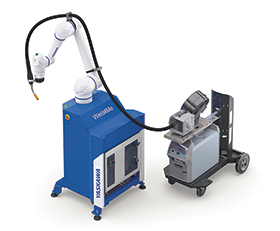

The development of user-friendly technology continues to spark greater confidence among business leaders for the implementation of robotic automation. Highly flexible and capable of optimising production, more affordable easy-to-program collaborative robots - or cobots - are quickly becoming the ‘go to’ for a variety of tasks, including arc welding.
Advances in cobot designs that include cast aluminium construction, easy-to-clean surfaces, longer arm reaches and higher payload capacities are especially beneficial. So much so that cobots with industrial pedigrees are expected to be the fastest growing segment for collaborative robots through 2025.
Whether supplementing manual welding or being rolled up to large, heavy workpieces, extremely versatile collaborative robots are making highly relevant applications come to life, especially for high-mix, low-volume production environments.
Hannes Crouse, sales manager at Yaskawa Southern Africa, shares some expert insights on cobot welding in the below Q&A.
Q: Cobot welding
• Good system to use for jobbing shops where you have a variety of parts that need to be reprogrammed.
• The ease of programming/teaching of the system by hand makes it possible for a welder to program the system without having to be a specialised robot programmer.
• Cobot welding brings consistent quality of robotic welding to your production.
Q: Key factors for cobot welding safety
• Yaskawa cobots have six torque sensors in each joint that are very sensitive in any position.
• They also have a power and force limiting (PFL) and functional safety unit (FSU) with wide functionality. This enables speed and position control, range limits defined by axis ranges, planes and cubes that can be created on the full body of the robot, as well as the tools to ensure the robot knows where it is at all times, and where it is not allowed to move to.
• This ensures that the robot will detect a collision (any force that exceeds the threshold value) and will stop its movements.
• The robot will also retract slightly when there is a collision to ensure that there is no clamping or entrapment.
• In addition, 3D sensors can also be installed to detect people and define their position in different zones. Green zone (the furthest) is the safe zone and the robot can function normally. Orange (closer to robot) or then red zone (closest to robot) can be a slow down or stop signal for the robot to ensure no welding spark or movement of the robot.
Q: How can businesses implement the system into their company?
• Identify welding operations that have many small to medium sized components that require a repeatable consistency in quality and output.
• Invite a Yaskawa sales representative for a discussion to decide on the correct solution for your company.
• Identify current welding personnel that you would like to be able to operate a system like this and send them for hands on training at Yaskawa close to the unit’s delivery time.
• Receive unit, set up and weld.
Q: Benefits of using cobot welding
• Easy to integrate due to small footprint.
• Easy to install and get first weld down (±30 minutes)
• Easy to operate as you don’t need to be a robot programmer. Yaskawa’s Weld4me package comes with welding wizard software making it easy to create welding jobs.
• You are able to relocate the unit as you see fit. There are models that are mounted on a stand so that you are able to move It with a pallet jack.
Q: Skillset required to operate the system
• Welding experience/knowledge will help as you will know a good or bad weld, weld angles etc.
• Basic computer literacy will help as you will need to be able to operate on a robot start box (choose settings and setup basic programs).
• It is recommended to participate in basic training (four day course) at Yaskawa SA.
Q: Collaborative welding tips
• Have a decent jig table. You want your parts to be perfectly positioned in the same place when you use any robot.
• Once you have your perfect weld set up, keep all the variables constant. Do not change gas or welding wire or metal supplier and expect the same finish.

© Technews Publishing (Pty) Ltd | All Rights Reserved